A muddy San Francisco hike could be much-needed reprieve from relentless storms—but watch your feet for banana slugs.
These yellow, larger-than-life slugs love moisture and are coming out to play in the rain, too.
“Banana slugs, and probably all slugs, really thrive in humid conditions,” said Ester Chang, San Francisco Zoo’s assistant curator of invertebrates. “They can’t really dry out, or they won’t be able to breathe.”
That’s why in drought conditions, Chang said, banana slugs often stay hidden, burrowing in mud or under any damp bark they can find. Composed mostly of water, these slimy gastropods require moisture to stay alive and protect their mucousy coats.
However, with rain lingering on trails and plants, it’s now safe for banana slugs to come out and explore—at around 6 inches of ground coverage per minute. Hence the increased likelihood of spotting one.
The banana slug genus is the largest type of slug in North America, reaching upwards of 9 inches. Eight banana slug species are localized to the West Coast, with at least three that Chang says the everyday person is likely to see in the Bay Area.
These various species each look a little different—and they’re not all the iconic yellow hue resembling our favorite breakfast fruit, the banana. A multitude of conditions, from the slug’s age to its light consumption, can determine its coloring, which ranges from bright yellow to mustard to green.
“This is sort of the optimal season when they start emerging, when they probably initiate most of their breeding activity and they’re looking for mates,” said Terry Gosliner, the California Academy of Sciences’ curator of invertebrate zoology.
Meaning, slug-spotting may not end with the storm.
“We’re probably gonna see more and more slugs for the next several weeks, if not months, depending on whether we continue to have wet conditions.”
